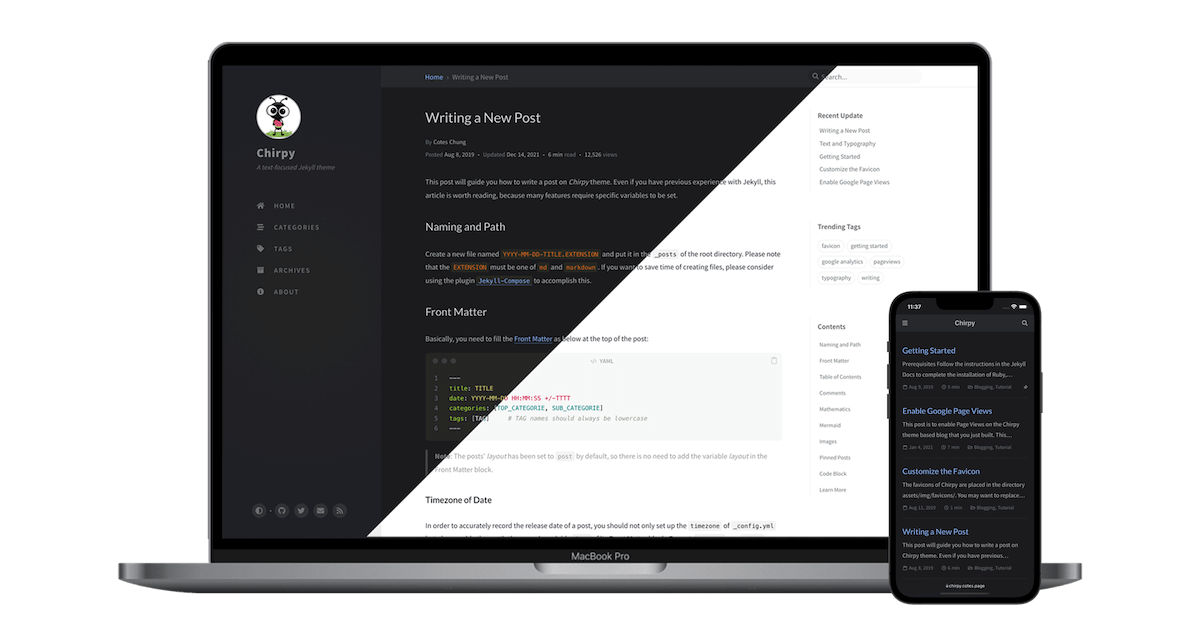A minimal, responsive and feature-rich Jekyll theme for technical writing.
Click to expand/close details
- Dark / Light Theme Mode
- Localized UI language
- Pinned Posts on Home Page
- Hierarchical Categories
- Trending Tags
- Table of Contents
- Last Modified Date
- Syntax Highlighting
- Mathematical Expressions
- Mermaid Diagrams & Flowcharts
- Dark / Light Mode Images
- Embed Videos
- Disqus / Giscus / Utterances Comments
- Built-in Search
- Atom Feeds
- PWA
- Google Analytics
- SEO & Performance Optimization
<<<<<<< HEAD
Before the deployment begins, check out the file _config.yml and make sure the url is configured correctly. Furthermore, if you prefer the project site and don't use a custom domain, or you want to visit your website with a base URL on a web server other than GitHub Pages, remember to change the baseurl to your project name that starts with a slash, e.g, /project-name.
Now you can choose ONE of the following methods to deploy your Jekyll site.
For security reasons, GitHub Pages build runs on safe mode, which restricts us from using plugins to generate additional page files. Therefore, we can use GitHub Actions to build the site, store the built site files on a new branch, and use that branch as the source of the GitHub Pages service.
Quickly check the files needed for GitHub Actions build:
-
Ensure your Jekyll site has the file
.github/workflows/pages-deploy.yml. Otherwise, create a new one and fill in the contents of the [sample file][workflow], and the value of theon.push.branchesshould be the same as your repo's default branch name. -
Ensure your Jekyll site has file
tools/deploy.sh. Otherwise, copy it from here to your Jekyll site. -
Furthermore, if you have committed
Gemfile.lockto the repo, and your runtime system is not Linux, don't forget to update the platform list in the lock file:$ bundle lock --add-platform x86_64-linux
After the above steps, rename your repository to <GH_USERNAME>.github.io on GitHub.
Now publish your Jekyll site by:
-
Push any commit to remote to trigger the GitHub Actions workflow. Once the build is complete and successful, a new remote branch named
gh-pageswill appear to store the built site files. -
Browse to your repository on GitHub. Select the tab Settings, then click Pages in the left navigation bar, and then in the section Source of GitHub Pages, select the
/(root)directory of branchgh-pagesas the [publishing source][pages-src]. Remember to click Save before leaving. -
Visit your website at the address indicated by GitHub.
On self-hosted servers, you cannot enjoy the convenience of GitHub Actions. Therefore, you should build the site on your local machine and then upload the site files to the server.
Go to the root of the source project, and build your site as follows:
$ JEKYLL_ENV=production bundle exec jekyll bOr build the site on Docker:
$ docker run -it --rm \
--env JEKYLL_ENV=production \
--volume="$PWD:/srv/jekyll" \
jekyll/jekyll \
jekyll buildUnless you specified the output path, the generated site files will be placed in folder _site of the project's root directory. Now you should upload those files to the target server.
It depends on how you use the theme:
-
If you are using the theme gem (there will be
gem "jekyll-theme-chirpy"in theGemfile), editing theGemfileand update the version number of the theme gem, for example:- gem "jekyll-theme-chirpy", "~> 3.2", ">= 3.2.1" + gem "jekyll-theme-chirpy", "~> 3.3", ">= 3.3.0"
And then execute the following command:
$ bundle update jekyll-theme-chirpyAs the version upgrades, the critical files (for details, see the [Startup Template][starter]) and configuration options will change. Please refer to the Upgrade Guide to keep your repo's files in sync with the latest version of the theme.
-
If you forked from the source project (there will be
gemspecin theGemfileof your site), then merge the [latest upstream tags][latest-tag] into your Jekyll site to complete the upgrade. The merge is likely to conflict with your local modifications. Please be patient and careful to resolve these conflicts.
=======
65a38c8 (Simplify the README)
To learn how to use, develop, and upgrade the project, please refer to the Wiki.
Contributions (pull requests, issues, and discussions) are what make the open-source community such an amazing place to learn, inspire, and create. Any contributions you make are greatly appreciated. For details, see the "Contributing Guidelines".
This project is mainly built with Jekyll ecosystem, Bootstrap, Font Awesome, and some other wonderful tools. The avatar and favicon design come from Clipart Max.
Many thanks to the contributors who participated in the development and to the folks who reported bugs or shared ideas.
Last but not least, thanks to JetBrains for providing the Open Source License.
If you like this project or have built something through it, please consider sponsoring it, and your support would be greatly appreciated.
This project is published under MIT License.







